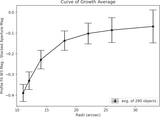Size and Albedo Constraints for (152830) Dinkinesh Using WISE Data
Abstract
Probing small main-belt asteroids provides insight into their formation and evolution through multiple dynamical and collisional processes. These asteroids also overlap in size with the potentially hazardous near-Earth object population and supply the majority of these objects. The Lucy mission will perform a flyby of the small main-belt asteroid, (152830) Dinkinesh, on 2023 November 1, in preparation for its mission to the Jupiter Trojan asteroids. In this Letter, we present data to support the planning of Lucy's imminent encounter of Dinkinesh. We employed aperture photometry on stacked frames of Dinkinesh obtained by the Wide-field Infrared Survey Explorer and performed thermal modeling on a detection at 12 μm to compute diameter and albedo values. Through this method, we determined Dinkinesh has an effective spherical diameter of ${0.76}_{-0.21}^{+0.11}$ km and a visual geometric albedo of ${0.27}_{-0.06}^{+0.25}$ at the 16th and 84th percentiles. This albedo is consistent with typical stony (S-type) asteroids. These measurements will enable the Lucy team to optimize planning for the flyby of Dinkinesh, including refinement of exposure times and flyby geometry. The data obtained from this mission will, in turn, allow us to better understand the calibration of our thermal models by providing ground truth data. The Lucy flyby presents a rare opportunity to study the smallest main-belt asteroid ever observed in situ.
- Publication:
-
The Astrophysical Journal
- Pub Date:
- November 2023
- DOI:
- 10.3847/2041-8213/acff61
- arXiv:
- arXiv:2309.13158
- Bibcode:
- 2023ApJ...957L...2M
- Keywords:
-
- Asteroids;
- Main belt asteroids;
- 72;
- 2036;
- Astrophysics - Earth and Planetary Astrophysics
- E-Print:
- Submitted to Astrophysical Journal Letters
